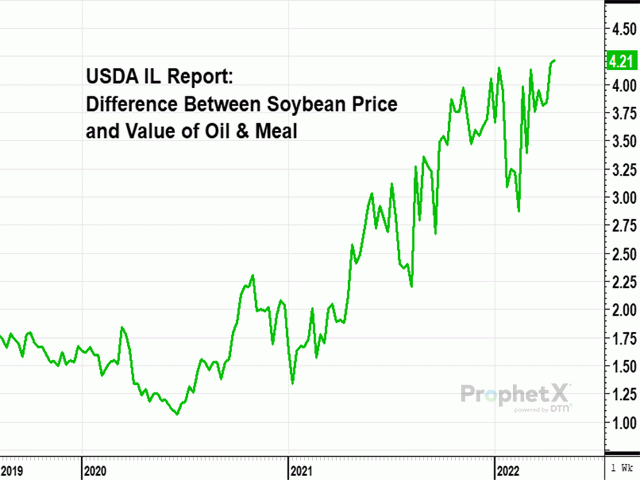Todd's Take
Soybean Crush Values Soar as Demand and Renewable Diesel Use Grow
What a difference demand makes. Sixteen years ago, the U.S. planted 75.5 million acres of soybeans and had 574 million bushels (mb) left over at the end of the 2006-07 season. China's economy was just starting to grow after a long history of widespread poverty and consumed 1.68 billion bushels (bb) of soybeans, or 20% of the world's soybeans.
This spring, the U.S. is expected to plant a record high 91.0 million acres of soybeans and may only have about 200 mb or less on hand when the new harvest arrives. China is now the world's second largest economy and is expected to consume 3.99 bb or 30% of the world's soybean in 2021-22. Cash soybeans that were less than $6 per bushel in 2006 are now trading well above $16 across most of the Midwest.
As big an elephant as China has been in changing the landscape for U.S. soybean demand the past two decades, another bullish wave is now carrying that demand to even higher peaks. The relatively new creation of renewable diesel, a superior version of traditional biodiesel that is said to be chemically identical to petroleum diesel, is attracting large investments from both traditional soybean processors and the petroleum industry.
DTN Ag Policy Editor Chris Clayton wrote about the demand potential of renewable diesel in the soybean market on Dec. 16, 2021, (https://www.dtnpf.com/…). I've also talked about this at events over the winter. But what we didn't know then that we are starting to see now is that these plans to invest in greater plant capacity aren't just staying on the chalkboard -- they're happening right now.
According to the April 29 report from the Department of Energy (DOE), renewable diesel plant capacity remained at 1.468 billion gallons per year in February, up 86% from a year ago, and is gaining on traditional biodiesel capacity of 2.232 billion gallons per year. The DOE also said 741 million pounds of soybean oil were used for making biofuels in February, down from 791 million pounds in January, but up 34% from a year ago.
P[L1] D[0x0] M[300x250] OOP[F] ADUNIT[] T[]
In DTN's daily market comments, we've been talking about seeing a rise in crush values since late December 2021. Whether we look at July futures prices or USDA's Illinois Weekly Soybean Report, crush values continue to stay ahead of the rise in soybean prices and are offering soybean processors highly attractive margins, much more than the historical norm.
In older days, it was the growing demand for soybean meal that typically led the charge to crush more soybeans. Today, meal demand remains impressive, but it is the demand for bean oil that is leading the way. As of Thursday's close, April. 28, July soybean oil is up 26% this month to 86.60 cents per pound, posting three new all-time highs this week.
Even if we knew nothing about the dramatic changes taking place, the futures spreads are telling much of the story. With first notice day on Friday, April 29, Thursday's May bean oil price of 90.60 cents a pound is 4 cents above the July, a strong indication of how eager commercials are to take delivery and secure physical supplies.
In the U.S., soybean oil is the main ingredient of interest for making biofuel. But around the world, the enthusiasm for going green has the entire world vegetable oil supply in a historically tight situation. There was some initial confusion this week, but Dow Jones reported that Indonesia, the world's largest producer of palm oil, banned palm oil exports Thursday to protect supplies at home. This is also a time when Ukrainian farmers will probably not be able to provide the world with its leading supply of sunflower oil exports.
With world crude oil supplies in a tight situation and many countries joining the effort to ban Russian oil, the push to make biofuel from soybean oil is on and, frankly, things might get a little crazy, especially after Brazil's soybean crop was hit by drought earlier this year.
This is no time for mere mortals to be predicting tops in either the soybean or soybean oil markets -- this is a time to get planting as soon as weather conditions allow.
Best wishes on a new crop season.
**
Comments above are for educational purposes only and are not meant as specific trade recommendations. The buying and selling of grain or grain futures or options involve substantial risk and are not suitable for everyone.
Todd Hultman can be reached at Todd.Hultman@dtn.com
Follow him on Twitter @ToddHultman1
(c) Copyright 2022 DTN, LLC. All rights reserved.




